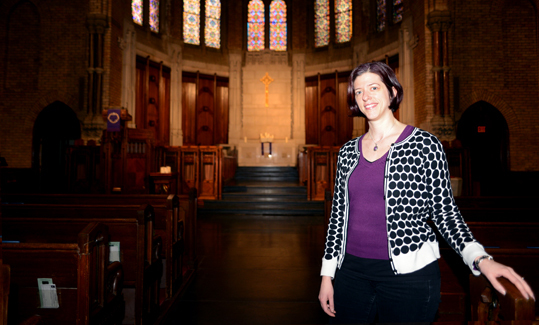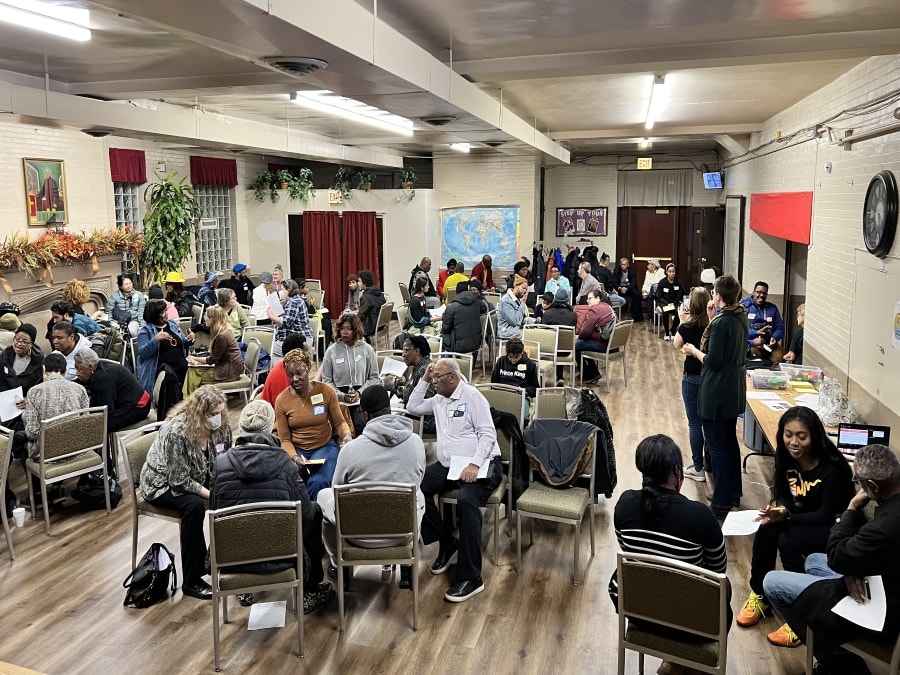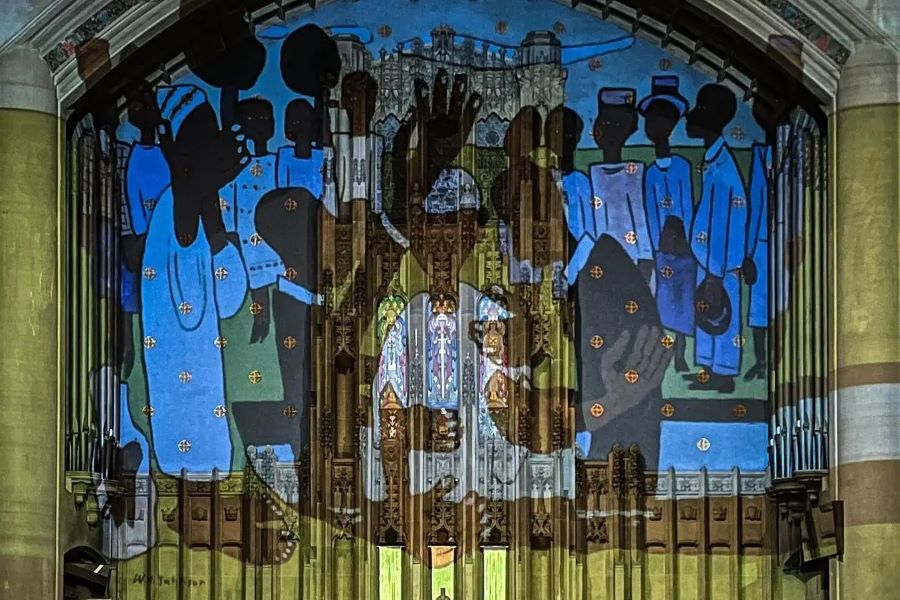As a theatre artist born and raised on the South Side of Chicago, I have vivid memories of long, late-night rides on public transit in my teenage years to get to and from a play—usually running at a theatre on the North Side or downtown. The time and bus fare were privileges I could afford, and it was a price I was happy to pay to feed my passion. When I got home to my own neighborhood, with plenty of vacant, industrious lots and under-used churches, I didn’t exactly imagine those spaces as a home for the arts. Now I do. As it turns out, I’m not the only one.
Arts Alliance Illinois, Partners for Sacred Places, and Bustling Spaces, LLC are collaborating with religious leaders on Chicago’s South Side to address the need for affordable, accessible space for neighborhood artists. The result is South Side Artists in Sacred Spaces (SSASS), which will distribute $135,000 in grant funding for capital improvements to sacred space participants and $20,000 to resident artists and arts organizations in rental assistance. The program is fully funded by a grant from the Department of Cultural Affairs and Special Events’ (DCASE) Chicago Arts Recovery Program. Over the course of five training sessions, participants will identify collective missions and values, learn the ins and outs of strategic partnership, and come to understand the legal side of space partnership. While similar initiatives exist in other major cities, SSASS is the first program of its scale in Chicago.

“The Department of Cultural Affairs and Special Events did a cultural asset mapping project in 2020 that was specifically related to theatre, and it showed a stunning lack of formal performance spaces on the South and West sides of the city, as well as a lack of rentable rehearsal spaces, training spaces, etc.,” attests Coya Paz, strategic director of Free Street Theater, an arts and culture organization that shares performance work free of cost. “It’s not that the arts aren’t happening—the vibrancy and range of SSASS artists demonstrates that—but space is incredibly hard to come by. Free Street lost our storefront space in Back of the Yards in August ‘22, and it took us over a year to find another space in the community to rent. There are a lot of storefronts left purposely empty (for tax credit) in divested neighborhoods. Meanwhile, what I’ve learned from the SSASS program is that there are a lot of sacred spaces that are eager to activate their spaces to serve the community in ways that are aligned with their values and mission.”
Paz is right. According to Architect Magazine, for example, there are an estimated 30,000-plus vacant lots within Chicago’s borders, and approximately 10,000 of these are owned by the municipal government. Much of this unoccupied space is concentrated in the systemically divested South and West sides.
With the fallout from the COVID-19 pandemic still rippling through the theatre community, permanently altering operations and prospects of companies, the SSASS program seeks to offer a solution. After all, theatre isn’t the only industry that was relegated to the digisphere during the height of the pandemic—many sacred spaces also moved their services to a fully digital platform. Without in-person attendance at plays, services, or community events, revenue and fundraising efforts for theatres and sacred spaces alike suffered.
For many South Side artists and theatres, this meant a struggle to keep up with rent, leading to several storefronts and studios being vacated and companies closing or going itinerant, adding to the growing list of itinerant companies in the city. For sacred spaces, this manifested as challenges in maintaining and updating their spaces to best serve their communities. Another change borne of the pandemic was an influx in theatre artists creating independent work that now needs a home. This left us with a South Side full of artists needing space and sacred spaces needing funding and community partnership.

“Artists and these houses of worship have not recovered since the pandemic like so many other industries have,” said Karen DiLossi, director of strategic partnerships and lead trainer for SSASS. “DCASE, Arts Alliance Illinois, and Bustling Spaces are giving all of us a very unique opportunity in their collective recovery process, and it should be looked at as an investment in communities, in what makes people happy, in third spaces, and positive outlets. I would encourage other philanthropic entities to start thinking in the same way.”
By connecting South Side artists and organizations who need space with sacred spaces looking to provide a larger variety of services and experiences, SSASS is reconnecting Chicago theatre to its itinerant, found-space roots and creatively addressing a foundational issue faced by the city: unoccupied space.
“This will allow lots of artists—primarily Black and brown artists who are serving folks of color—working across various media to have space near their homes,” said Chicago theatre artist Quenna Barrett. “As a person of faith and someone interested in the role of arts in civic spaces, I’m excited for this partnership between artists, faith leaders, their congregations, and the arts practice. The arts have a unique power to invite critical thought and create space for civic dialogue, to use creativity to help solve real-world problems.”
Barrett thinks this program could help foster new generations of artists, allowing young Black kids to see a young Black painter or theatre or music group in a way that maybe they’ve never seen before. Visual artists could add to beauty and space making, perhaps helping to rethink the paint colors of a church to be more inviting, welcoming, and calm. Over time, Barrett reasoned, the relationships could perhaps result in communities valuing these artists and creative processes in helping to think and work through complex community issues. The notion of symbiotic relationships blooming between sacred space and the arts is shared by Rev. David Black of First Presbyterian Church.
“Many old churches are floundering to keep their facilities relevant and sustainable, and making them available to artists is a way to mutually empower artists and congregations to continue building their work,” Black said. “As we’ve experienced with artists who use our building, this relationship is deeply symbiotic and creates a virtual cycle. The artists beautify our space and bring in interested—and interesting—people. Their presence is a potent story which aids in our fundraising to sustain our building. In return, the artists are given access and support to make and show art in their own communities. I truly believe that in the future, this type of arrangement will be commonplace.”

Participating artists and sacred spaces will have the opportunity to practice negotiating partnerships in their third training session and will pursue potential partnership negotiations by the end of their five-session training, though some have already identified authentic fits during the training and have begun the partnership process. Moreover, SSASS training equips participants with the tools to identify and align their values surrounding the content of the art showcased in sacred spaces. According to DiLossi, the artists and congregations can work together “to come to an agreement about that part of the puzzle,” with congregations “open to hearing out the artists’ perspective.” DiLossi added that “there is a lot of mutual respect across the table.” These partnerships are not one-size-fits-all and may vary in duration, and in terms that best serve both the artists and sacred spaces.
In his reflections on the future, Frank Maugeri—founder of Cabinet of Curiosity, an organization comprising collectives who collaborate on original celebrations and productions—dreamt about how this initiative could develop further by “transforming any abandoned or unused space, like a shutdown gas station or unused grocery store, into a site of ritual and ceremony,” which the South Side Chicago community has seen in the reclamation work of artist and professor Theaster Gates.
“All across the country, we are seeing large theatre companies, companies we all thought were solid in their finances—mostly due to their artistic quality, their audience following, and lastly their permanent venue—closing their doors, cutting staff and/or programming, or losing their space,” said DiLossi. “The impact of this program may bring more artists back to the core of why they became artists in the first place: To do the art, not to maintain a building. I have said many times that I could introduce any artist to many pastors who will tell them not to own a building. By harnessing the beauty and stature of these historic houses of worship, these artists are having these facilities do exactly what they were meant to do 25, 50, or 100, 150 years ago: bring people together for a communal and perhaps even spiritual experience that art and worship can both create. These houses of worship are community centers in their neighborhoods, and the artists can help them fully realize that potential.”
This return is essential in a city whose arts culture was built on thrilling theatre in unique spaces, but is now dominated more by capital campaigns than community connections. South Side Artists in Sacred Spaces re-centers these community connections to create new homes for the artistic excellence that has always existed on Chicago’s South Side, inviting artists and community members to see their own vibrancy reflected in their immediate surroundings. All of which brings a smile to my inner South Side teen theatre nerd.
Tina El Gamal (she/they) is a Chicago-based theatre artist, educator, and administrator. She was featured on New City Stage’s Players 50, 2022.


